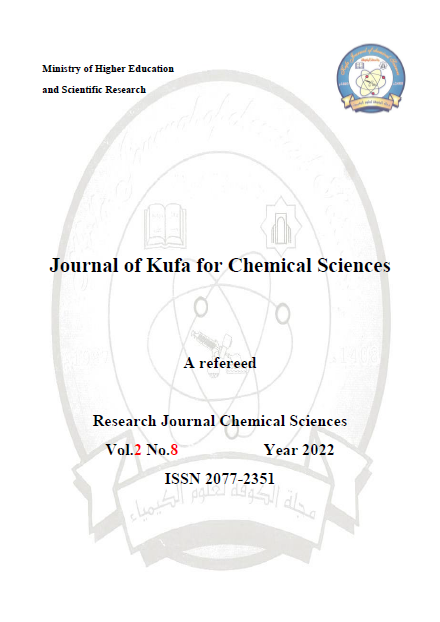Synthesis , Characterization and physical studies of Some New Co(II), Ni(II), Cu(II) and Zn(II) Complexes with (E)-4-methyl-3-nitro-N-(2-(1-(pyridin-2-yl)ethylidene)hydrazine-1-carbonothioyl) benzamide Ligand
Keywords:
Thiosemicarbzone, Metals (Cu(II), Ni(II), Zn(II)Co(II) Complexes, Magnetic SusceptibilityAbstract
New series complexes of Cu(II), Ni(II), Zn (II) and Co(II) ions were derived from the novel thiosemicarbazone compound, (E)-4-methyl-3-nitro-N-(2-(1-(pyridin-2-yl)ethylidene)hydrazine-1-carbonothioyl) benzamide (MNEC-H) ligand was prepared in three steps. The step one the reaction between acetyl pyridine with hydrazine hydrate at room temperature to obtain (E) - 2 -(1 -hydrazonoethyl)pyridine. The Second step 3-nitro 4- methy- benzoyl chloride was refluxed with potassium thiocyanate in acetonitrile solvent forming 3-nitro 4- methy- benzoyl isothiocyanate. The third step of the reaction is summarized by the refluxing the mixture of (E) - 2 -(1 -hydrazonoethyl) pyridine and 3-nitro 4- methy- benzoyl isothiocyanate in acetonitrile solvent to form the desired free ligand (MNEC-H). Two types of the element complexes were synthesized and investigated, the chloride as well as acetate compounds through employing different mole ratios 1:1 (L:M) and 2:1 (L:M) whereas L and M represent the (MNEC-H) ligand and metal salt respectively via using metal chloride and metal acetate salts to gaining [(MNEC-H)MCl]Cl and [(MNEC-H)2M] structures. The various available spectroscopies and techniques were used to characterize and confirm the formula of the free ligand (MNEC-H) and its element compounds. 1HNMR, 13CNMR, IR, UV-vis, mass spectra, CHNS, magnetic effective moment, conductance values. The cyclic voltammetry of the prepared element complexes were recorded in DMSO solvent to investigate their redox behavior. The Cu(II) compounds showed quasi reversible process at the cathodic potential whereas the Co(II) and Ni(II) complexes displayed one irreversible system at the oxidative potential. All the employed techniques and measurements confirmed together that the chloride compounds arranged as tetrahedral four coordinated [(MNEC-H)MCl]Cl in neutral formula whereas the acetate compounds adopted octahedral six coordinated [(MNEC-H)2M] in neutral structure too. The Zn(II) chloride and acetate complexes were confirmed as diamagnetic species according to the effective magnetic data. While Cu(II), Ni(II), Co(II) and Zn(II) chloride and acetate compounds appeared as paramagnetic species.
Downloads
Downloads
Published
How to Cite
Issue
Section
License
Copyright (c) 2023 Journal of Kufa for Chemical Sciences

This work is licensed under a Creative Commons Attribution 4.0 International License.
Open-access Statement
The journal « Journal Of Kufa For Chemical Sciences» provides immediate open access to its content on the principle that making research freely available to the public supports a greater global exchange of knowledge. Full-text access to scientific articles of the journal is presented on the official website in the Archives section.
This is in accordance with the BOAI definition of open access. The licensing policy is compatible with the overwhelming majority of open access and archiving policies.
The journal «Journal Of Kufa For Chemical Sciences» is an open access journal, which means all its content is freely available without charge to the user or his/her institution. Users are allowed to read, download, copy, distribute, print, search, or link to the full texts of the articles, or use them for any other lawful purpose, without asking prior permission from the publisher or the author as long as they cite the source.The journal is licensed by Creative Commons Attribution International( CC Attribution 4.0) .


